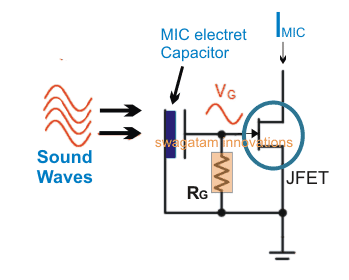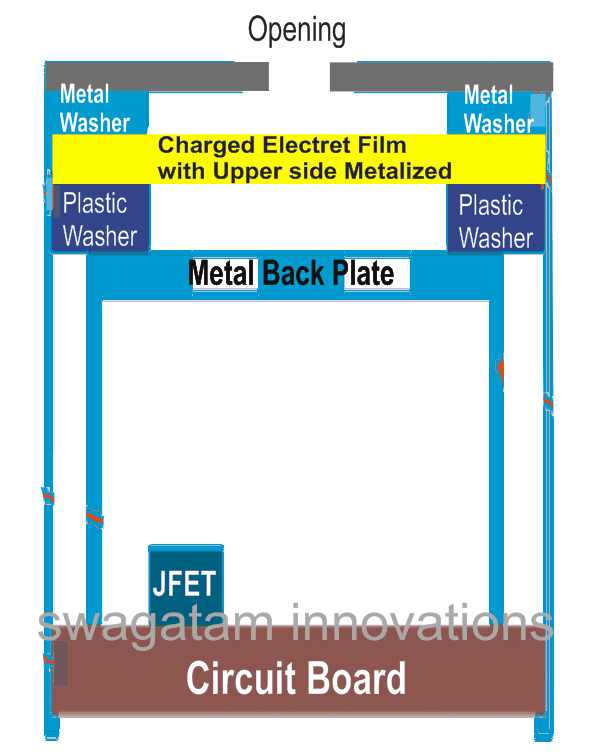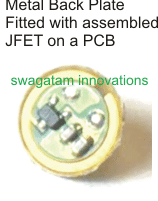
In this post I have explained how electret microphone devices work, through appropriate diagrams and formulas.
What's a Microphone
A microphone is a device designed for transforming weak sound vibrations into tiny electrical pulses, which can be then amplified through a power amplifier over a loudspeaker for achieving a louder reproduction of the sound.

The most common and versatile form of microphone device employed in electronic circuits are the electret microphones.
These MICs are miniature in size, extremely sensitive, and are able to capture or respond to sound vibrations from across all angles, that is from across a full 360 degree angle.
How Electret Microphones Work
- An electret microphone mainly consists of a diaphragm, a couple of electrodes and an in-built JFET.
- The diaphragm is made of thin Teflon material and is also termed as “electret” and hence the name electret MIC.
- This electret has a fixed charge (C ) and is embedded between the two electrodes.
- The electret along with the two electrodes takes the form of a sensitive variable capacitor whose outer surface responds to sound vibrations, giving rise to a varying capacitance across the two electrodes.
- Sound waves in the form of air pressure moves one of the electrodes facing the open side of the MIC, causing effective variations across the capacitive plates .
- The instantaneous value of the varying capacitance of the MIC becomes directly proportional to the sound pressure hitting the electret at that instant.
MIC Capacitance Calculation
As mentioned earlier, since the charge value on the Teflon material is fixed, the potential difference developed across the MIC capacitor becomes equivalent to the value which can be expressed with the following formula:
Q = C.V
Where Q is the charge (which is fixed for the electret)
C indicates the capacitance, while the V signifies the developed voltage level or the potential difference across the electrodes.
The above discussion implies that the electret MIC's internal construction behaves like a AC coupled voltage source.
Most electret MICs have an in-built JFET whose gate is connected with the electret capacitor forming an buffer for the MIC’s capacitor.
Since the charge of the capacitor is fixed, this buffer needs to be of a very high impedance and that’s exactly why a JFET is used.
The following diagram shows the basic internal wiring layout of a typical electret microphone.

Sound vibrations hitting the electret capacitor varies its capacitance producing a modulating voltage for the gate of the JFET, indicated as Vg.
This modulation alters the current flow pattern across the drain/source of the JFET, represented as Imic.
A stabilizing resistor RG can be also seen connected internally across the gate and source of the JFET, it is ensured that this resistor has an extremely high value to avoid shunting of the electret output for the JFET gate.
Sectional View of an Electret MIC internal Structure
The following image shows a sectional cut view of an example electret MIC.

One of the electrodes is formed by metalization of its layer over a charged polymer film.
This metalized layer is joined with the case of the MIC through a metallic washer.
The case of the MIC is in turn connected with the source lead of the internal JFET.
The other capacitor plate or the second electrode is made by using a backside metal plate, which can be seen separated from the metalized layer film by a plastic washer. This plate is then connected with the gate terminal of the JFET
Sound waves hitting this plate generate a strain level on it, thereby varying the distance between the capacitive electrodes, and causing an equivalent potential difference to develop across them.
This varying voltage across the drain of the JFET is used as the output for a subsequent preamplifier circuit stage which further amplifies this to a level which can be reproduced over a loudspeaker, and an amplified version of the sound waves can be heard.
Internal Composition of an Electret MIC
A following images show the actual parts used inside a typical electret MIC





If you have more questions regarding how electret microphones work, please do not hesitate to put them forth through the comments.


With over 50,000 comments answered so far, this is the only electronics website dedicated to solving all your circuit-related problems. If you’re stuck on a circuit, please leave your question in the comment box, and I will try to solve it ASAP!